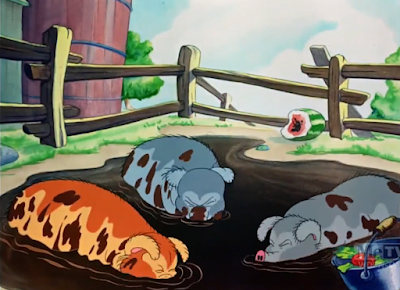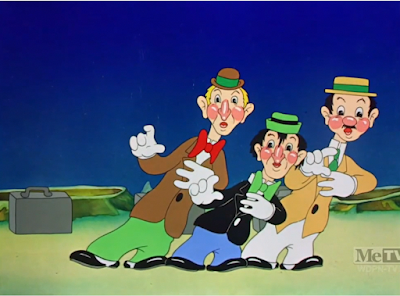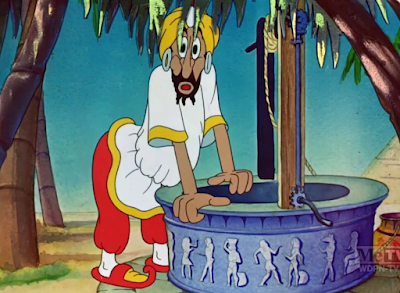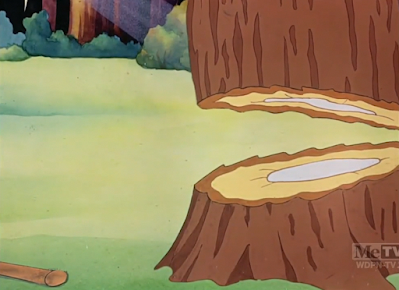Release Date: June 3rd, 1939
Series: Merrie Melodies
Director: Tex Avery
Story: Dave Monahan
Animation: Virgil Ross
Musical Direction: Carl Stalling
Starring: Cliff Nazarro (Narrator), Mel Blanc (Adolphus Hambone, Buck Dodgers, Singer, Man, Wishing Well, Nathaniel Nevermiss, Ant), Danny Webb (Elmer, Prisoner, Chopoffski), The Sportsmen Quartet (Chorus)
Proto-Fudd makes his final bow in the end of an Avery era and onto the next, an era dominated by mediocre, quota-filling spot gag cartoons such as the one presented before us today. Living up to the brilliance of Thugs with Dirty Mugs immediately after said short was released is a foolish expectation, but Believe It or Else is a warning sign for the cartoons that would begin to litter Avery's unit for the remainder of his Warner tenure. Here, the spot-gag format is themed around unbelievable facts and intriguing tidbits à la Ripley's Believe It or Not!.
Mimicking the vocal stylings of one Robert Ripley (whose Ripley's Believe It or Not! series had been running strong in newspaper syndication since 1918, later bringing the format to radio and film in the early 1930s), Cliff Nazarro stars as the soft-spoken narrator, reassuring the audience of the "interesting facts" in store.
Proto-Fudd ends his career in the exact same manner of how he started; strutting horizontally across the screen and disrupting the flow of the action. His interruption here serves more of a purpose than the dozen in Little Red Walking Hood, posing as a naysayer through the aid of his "I DON'T BELIEVE IT" sign. The addition of a shadow projected against the red curtains further immerses him in the scene, indicating that his presence effects the environments around him. His design here is much less stylized and streamlined than the Irv Spence-inspired appearances beforehand.
A fade in turns into a pan past a vast number of empty milk bottles littering the inside of a house as Nazarro provides the narration. "First, believe it or else, Mister Holstein Cud has consumed 50 quarts of milk a day for the last two years."
Indeed, the camera settles on a rotund man guzzling bottles of milk, disgusting gargles providing a chorus against Carl Stalling's sardonic song choice of "You Must Have Been a Beautiful Baby."
"Mister Cud, how do you feel?"
Cud's reply arrives in the form of a long, loud, bellowing moo. While the gag lacks conviction (a prevailing criticism all through the picture), the belabored animation in tandem with the seemingly interminable bellow proves to be a nice pair.
Milk guzzling resumes as we fade to black.
"Now, last year while traveling through India, I came upon this Hindu snake charmer." Similar to the milk gag, Avery makes a sly attempt to build up to the gag through deceivingly picturesque background pans. The camera halts upon the sight of a snake serving as a snake charmer itself, which, to Avery's credit, is where many directors attempting the same gag would likely have ended.
Instead, Avery completes the role reversal. Stereotypes aside, the animation of the man literally snaking out of the pot maintains the weight and flow necessary to immerse the audience in the gag, following a kinetic, pulling rhythm.
Rather than another fade to black and back in, Avery eases monotony through a cross dissolve, which serves as a cue for Nazarro's next introduction. Here, he introduces a man whose hobbies include building model ships in bottles. A shelf displaying an example of said models once again fool the audience into expecting a normal punchline.
"Normal" is not a phrase synonymous with Tex Avery. He provides a literal translation of the narrator's words.
"Now, back to America, we find a mister Adolphus Hambone, a native of Arkansas, who is the world's long distant hog caller." In discussing Hambone's abilities, Avery makes history through providing the first mention of Walla Walla, Washington, a Warner Bros favorite bit of alliteration that would continue to pop up in cartoons for decades to come.
Hambone's appearance makes one appreciate and long for Irv Spence's design sense that littered A Feud There Was. While the background paintings are pretty, Hambone himself isn't incredibly appealing.
With a toothy grin at the audience, Hambone works his "SOO-EEEEEEEEEY!" magic. Though his design may not be appealing itself, the poses as he calls for whatever hogs lurk in the distance have a concrete line of action and clear silhouette, adding a nice elastic energy that serves as a stark contrast to the more conservative anatomy seen with Holstein Cud.
An overlaid pan of a map on top of Hambone's calls succeed in their attempt to provide theatrics; the spot gag cartoons aren't known for their cutting edge cinematography.
The next joke is admittedly dumb, but a case of Avery reveling in said dumbness, which typically yields good results. It is easily one of the strongest sequences the cartoon has the offer.
Sure enough, per the narrator's words, the three pigs hear Hambone's calls, halting their wallowing to take a listen. A shift in poses is all that is necessary to anthropomorphize the hogs, their alert stance indicating that a punchline is soon near.
Said punchline is delivered through the gorgeous vocals of The Sportsmen Quartet as the hogs harmonize in rich, unmistakably human voices: "I heeeeeeaaaar you caaalliiiiing yoooooooooo-hooooooo!"
Fade out and in to the next bit of business, focusing on a man who hasn't been out of his room for 50 years. Stalling's floaty accompaniment of "Long, Long Ago" paired with the gorgeous surroundings of the outside serve as a great way to mock the man's solitude.
Especially when the glacial horizontal speeds up to reveal an old coot behind bars, reciting the immortal wisdom of Lou Costello: "I'm a ba-d boy!"
Nearly every single gag showcased thus far has been introduced through a slow, rolling, scenic pan, which is quick to grow monotonous. Thankfully, Avery temporarily eases the routine in the introduction of his next act: the human basketball.
Elastic, spirited animation combined with a rousing score of "Frat" and realistic ball bouncing sound effects render the joke easier to appreciate than others--especially when he throws himself into the hoop by breaking the physical bounds of reality and floating in mid-air.
Understanding the audience needs a break from the repetitive structure touted by the cartoon thus far, the narrator opts to step up into the ring himself and display an optical illusion.
"I'm going to prove to you that these two squares are not the same size." Though the motion itself of the hand gesticulating at the squares teeters on the crude side, stiff in motion, its addition is nevertheless welcomed and furthers the immersion into Tex Avery's meta world of cartooning.
"Now you people in the audience, close your left eye."
The left side of the screen grows dark, aided by an ironically childish violin slide to accompany the action.
Same routine for the right.
"Ah ah, ah ah! Somebody peeked!" Both the ascending, furtive violin slide sound and quick manner in which the eye closes again after getting caught compliment the joke nicely. Even if the audience members did abide by the narrator's rules, just hearing his condescending chastising would be enough to deliver the joke, able to stand on its own legs without visual aid.
Rather than attempting to continue on with the illusion, the narrator moves onto another one ("And no cheating from the audience this time, please!"), clearly indicating that the aforementioned presentation was included solely for the cheating gag and not for the illusion itself. That is where the next order of business comes in.
"Here, you see three triangles composed of nine matches." The disembodied gloved hand returns to stress the presence of said matches. "Now, I'll show you that it is possible out of these triangles to make 37 triangles."
Enter one of Avery's best bits of the cartoon thanks to its fervent energy. As mentioned previously, where this short (and other travelogues in the same nature) falters is primarily on part of a lack of dedication and conviction, phoning in most of the gags. However, instances where Avery is locked into a gag and doesn't phone it in often provide wonderful bursts of energy and freshness. Here, the narrator magically summons dozens and dozens of matchsticks, his "This one here, over there, over here, here here here there here there here over there here"-ing growing more breathless, fast, and rapid, all while sustaining the softspoken psuedo-Ripley impression. That Stalling's music score morphs from "Sobre las Olas" to the William Tell Overture to meet the rigorous action is certainly not lost.
Perhaps the best part of the gag is the patronizing comments of the narrator after the demonstration is complete, made better by the same, calm delivery; panting and being out of breath would sever the joke. "There now, isn't it easy? Try it on your friends."
"Atop Mt. Palomar, California, science takes a step forward with its new 200 inch telescope, and brings to you, through millions of miles of space, actual pictures of life on Mars." Tex Avery once again lures the audience into a false sense of security and domesticity through intricate paintings of an observatory and a shot of the planets above. While the animation of the stars skirting past the planets is reused from 1937's Clean Pastures (albeit in reverse), it's nevertheless practical and serves as a fine segue to the next order of business. Flames spinning around Mars' axis contributes just the right dose of whimsy.
One realizes just how (no pun intended) down to Earth the Warner cartoons have been in the '30s, even the most high energy of cartoons still encased in a domestic setting (the only main outlier really being Porky in Wackyland): it's taken 9 years for a glimpse of life on another planet. Avery nevertheless breaks in the new surroundings incredibly well, combining fantastical elements with plenty of humor and energy, rockets zinging left and right with heavy traffic. The recent MeTV restoration really brings out the richness of the colors and tones.
Further history is made through the introduction of Buck Dodgers, a not so subtle take on popular science fiction hero Buck Rogers. Most people today have come to associate him with Chuck Jones' masterpiece Duck Dodgers in the 24 1/2th Century. Note the "NO RIDERS" engraved on the side of the ship.
Enter Buck Dodgers, Avery and Mel Blanc milking the typical flamboyance of 1930s superheroes to the nth degree. Blanc defaults to a more dopey antithesis to both Dodgers' role and animation, guffawing "Hullo, folks. Don't miss me in next Sunday's funny paper!"
"It's a killer thriller! Huh huh!"
The departure of Dodgers serves as the perfect vehicle for Elmer to make an impromptu appearance, armed by his floaty musical motif of "The Umbrella Man."
Danny Webb provides the proto-Fudd's vocals for the last time as he grouses "I don' believe it!" before departing at the speed of light. While Elmer's appearances in this cartoon feel gratuitous at best, the concept of him heading to Mars in his own rocket, essentially mimicking the exact behavior he is refuting, is pretty funny.
Avery reuses the same recycled Clean Pastures animation, now tailored to hone in on the moon, upholding the space motif and reducing the spontaneity of one single Buck Rogers gag and nothing else. The narrator tells the audience that he will prove that there is no life on the moon, aided by the rather crude but functional animation of the moon's craters clustering together and zooming in. A still painting likely would have worked much better.
And, seeing that the narrator directly said that there is no life on the moon, enter three lives on the moon as indicated through tiny moving specks. Any director handling a spot gag cartoon, not just Avery, loved to have brief moments of vulnerability from the narrator, demonstrating his flustered nature as the antics on screen betray him. Such happens here as the narrator asks "Saaay, what's this?"
Enter three unmistakable Earthlings, briefcases in tow as they casually strut about the moon. No wonderous gazes or gawks at the splendor of being on an unfamiliar planet, just marching around like business as usual. It takes the narrator's interrogation for them to pause.
"We're wit' da Major Bowes unit, numbah seventy t'ree," explains the middlemost player. Major Edward Bowes was responsible for the most popular amateur hour radio show and boasting a long run from 1935-1952. Warners likewise got a lot of material through references to the program.
"Hey, which way is it ta Cleveland, hah?" Avery's unit wasn't hailed for its lifelike motion and animation, but there was certainly an attempt to capture bits of natural acting such as blinks and head tilts, prominent in the current scene. The narrator kindly explains that they've got the wrong show, but is interested in hearing their routine anyhow.
Once again provided by the utter talent that is The Sportsmen Quartet, the boys launch into a slow, saccharine but nevertheless rich and pleasing chorus of "Sweet Genevieve." In spite of the slightly ridiculous appearance of the trio, Avery is nevertheless able to nail the perfect amount of delicacy needed for the gag. The abilities of the Sportsmen need no dissertation to assert their own skill.
As such, the narrator's interruption of "You'll have to hurry up--we're losing time!" comes as a sharper contrast to the slow strains of their song. Thankfully, the boys take it in good spirit and abide by his wishes.
Yet another highlight of the cartoon thanks to the pure exhilaration and freneticism in the quartet's movements as they attempt to speed up their song. Not only do their motions grow more spastic, their voices continue to climb in both pitch and tempo. At the sequence's peak, only a thin line of brush strokes held for one frame serves as any sort of in-between through the key poses. Comparisons to Avery's own riotous routine parodying The Ritz Brothers in A Sunbonnet Blue are not unfounded.
Classic Averyesque exit-enter-exit shtick ensues just in time for the singers to take a bow.
Back to Earth and back to the rolling, picturesque pans, the music score here an ominous rendition of "A Vision of Salome". The narrator now claims he's discovered an ancient Egyptian wishing well able to grant real wishes. A halt of the camera and arrival of a man indicate that the audience is about to observe the altercation described above.
"O wishing well, o wishing well..." Mel Blanc bestows a stereotypical Middle-Eastern accent upon the man, "I wish I had a million dollars!"
In addition to the man, Blanc also provides the phantasmagorical response from the wishing well itself: "Sooo dooo I!"
Arbitrary as the reaction take may be, it is at least made more palatable through the music synchronizing with each startled pose struck by the man.
Gratuitous dose of Elmer resumes.
"Not long ago, while in the logging country of Tall Timber, I found mister Chopoffski, the world's fastest wood chopper." Little deviation from the short's setup is made through the picturesque establishing shot and close up of our newest guest. Chopoffski's outfit is nearly identical to the one sported by the antagonist in Avery's next and more engaging effort, Dangerous Dan McFoo.
Thankfully for the audience, Tex Avery knew his speed and understood the gravity in such a grandiose title of world’s fastest woodchopper. Chopoffski soon transforms into a blurred mass of brush strokes, Treg Brown’s chopping sound effects and Carl Stalling’s inspired musical accompaniment completing the transformation and successfully living up to the audience’s expectations. A subtle pan right displays the damage taken to the tree to ensure that Chopoffski's speed indeed has rightful consequences against his environments.
Pan back to Chopoffski, his reaction to the teetering tree limb now a bigger priority than the tree’s condition itself. Creaking wolf sound effects and the lumberjack’s cautious steps backwards inform the action succinctly.
“TIMBEEEEEEEEEEEEERRRRRRRRR!!!” In a way, the sequence here foreshadows a much funnier and more rapid backfiring of lumberjack abilities displayed in Avery’s wonderfully hilarious Droopy cartoon Wags to Riches.
Instead of the tree falling on top of Chopoffski in the manner of the aforementioned cartoon, Avery butchers the audience’s expectations another way: having a very small tree trunk topple over itself.
Another wonderful example of Avery’s dedication rescuing a gag and elevating it into something funny, no matter how stupid the joke itself may be. Avery deliberately attempts to heighten the suspense and dramatics of the tree chopping through suspenseful music, foreboding creaking sound effects, strategic camera movements emphasizing the presence of the tree (whether through focusing on it to display the damage it’s taking or panning away to make it seem taller than it really is), and the reactions of Chopoffski himself. That Chopoffski very clearly approaches a tall tree in the prior establishing shot makes the payoff all the more amusing—there are absolutely no hints towards the result until the viewer sees it for themselves.
Cross fade to one Nathaniel Nevermiss and his loyal subject, both personalities (and namesakes for Nathaniel) telling a story through their designs and demeanor alone. Little exposition is required.
Avery repeats his routine from Hamateur Night, which felt much more potent and immersive in the prior cartoon. The theatrics and suspense present in the aforementioned example—or even the prior sequence with Chopoffski —are lacking in this current demonstration, Avery’s lack of conviction evident through standard crutches. A wild take from Nevermiss rescinds his credibility, and the remorseful ambience in Hamateur’s presentation is absent.
Nevermiss’ unflappable query of “Is there a doctor in the house?” remains the most intriguing portion of the sequence. Though the routine isn’t unfunny by any means, it isn’t able to distinguish itself or make an argument for its presence. Rather, it serves as one of Avery’s defaults, an attempt to fill time. Then again, couldn’t that be said for the entire cartoon?
The next sequence was cut from the MeTV airing due to racial stereotyping, which is just as well: the pun between witnessing the birth/berth of a baby is presented with levels of straight laced apathy that only Ben Hardaway could mimic.
At the very least, the next sequence about hearing the sounds ants make fares better. While the punchline of the ant screaming “HEY MABEL!!!!!” to its mate in that bellowing, distinctive Mel Blanc shout would hardly be innovative in the coming years, it truly is a gag that is funny every time. Here is certainly no exception.
However, with that said, an slow iris transition does seem oddly misplaced, at least so far along in the cartoon; one gets the impression that the short is about to end there and dissolve to the ending Merrie Melodies titles. After all, it is 7 minutes and 48 seconds into the cartoon. Nevertheless, it’s mainly a misused transition to segue to the true last act of the cartoon.
Believe it or Else’s finale once agains seeks the success of Hamateur Night for inspiration. Upon the narrator’s declaration that “Horus Buzzsaw” can saw a person in half, Elmer once again grows contradictory in the midst of his aimless strolling.
“It's done with mirrors!” Danny Webb’s Joe Penner inspired vocals for the proto-Fudd will always be amusing, regardless of one’s knowledge of the connection. “I don’ believe it!”
Narrator invites Elmer to step into the box and take a look for himself. The proto-Fudd’s nonplussed glances at the camera are a welcome addition.
Buzzsaw works his magic, Carl Stalling’s ascending musical score attempting to make the menial act more engaging. Unfair as it may be to compare to the standards of Avery’s best, it does beg the question just how fast the speed would look and move had Avery made this cartoon during his tenure at MGM.
An intact Elmer is introduced to the audience through a brass fanfare. Allowing both doors to swing open at slightly different intervals stresses the box’s sawed condition and the miracle that is proto-Fudd’s intact condition.
“Heh heh heh. I STILL don’ believe it,” Elmer guffaws. Sticking to his “I don’ believe it motif” is infinitely more amusing than a mere rebuttal of “Told ya” or a raspberry at the narrator.
Thus comes the obvious that even audiences in 1939 have come to expect. Elmer scrambling to catch his runaway hide after the curtains have closed is at least a more satisfying end than an iris out on the curtain close. We fade instead.
Tex Avery’s travelogues are sometimes difficult to fault, but the contrast between this and the brilliance of Thugs with Dirty Mugs is staggering. In fact, Thugs is likely why this cartoon exists to begin with; Avery often used his travelogues as a cheater cartoon—they were quick ways to garner polite laughs and didn’t require a strenuous amount of thinking, composition, or care into them. Something to please the box office and meet the quota. No matter how burnt out one was, the schedule still remained tight. Avery was famous for overexerting himself with his shorts, and it proves difficult to shame him for these lesser shorts—especially when these jokes were once much more novel than they are now.
Nevertheless, despite its mediocrity, Believe It or Else still has a number of shining moments, which make the more routine bits of business seem worse by comparison. Sections such as the hog calling, the Major Bowes trio, the optical illusions, and the Chopoffski sequence at least have payoffs that are actually amusing, or a much more noticeable level of care and dedication poured into their filmmaking than other gags. Avery’s interest versus disinterest becomes incredibly easy to distinguish by watching this cartoon alone (how many horizontal scenic pans are we met with back to back again?)
Thus also ends the tenure of one proto-Fudd. His next appearance would be under the animated direction of Chuck Jones and vocal direction of Arthur Q. Bryan, who would make his own Warner Bros cartoon debut in Avery’s Dangerous Dan McFoo, future Fuddspeak and all.
Proto-Fudd is hardly an endearing entity, but he made for some particularly rousing entries from Avery. Little Red Walking Hood, Cinderella Meets Fella and A Feud There Was are all wonderfully absurd and energetic cartoons in their own right. It truly is a shame that his appearance here seems to shoehorned in, his interruptions more of an excuse for extra laughs rather than serving as a seemingly innocuous but important plot piece as in Little Red Walking Hood. Nevertheless, Avery has outgrown his own need for the proto-Fudd and knew when to retire his characters. Though the real Fudd would understandably be more receptive with audiences, there was an odd charm in the proto-Fudd’s inherently surrealistic role as well. Thus puts an end to one Avery era and moves to another.










.gif)



















































.gif)









































No comments:
Post a Comment